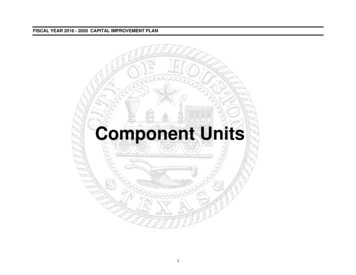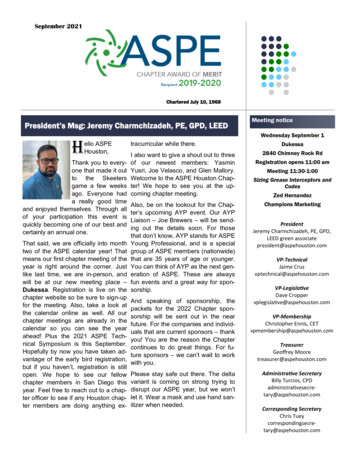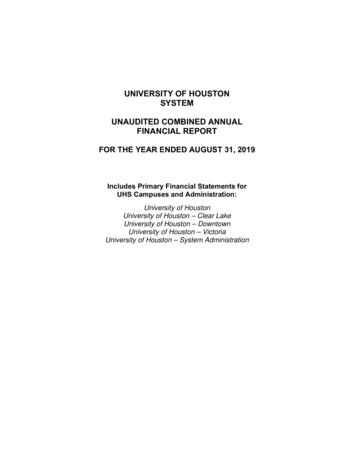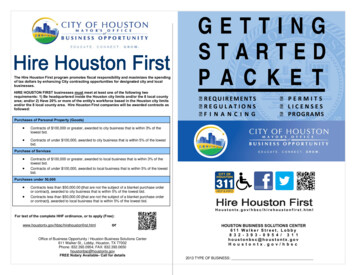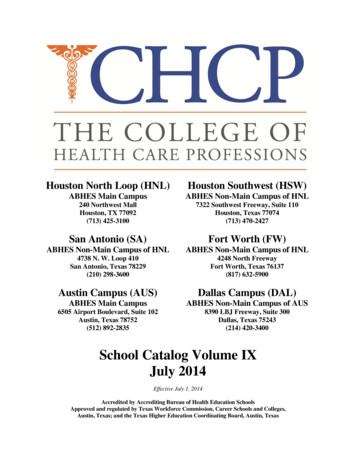
Transcription
UNIVERSITYLAWMICHAEL A. OLIVASWilliam B. BatesDistinguished Chair in LawDirector, IHELGmolivas@uh.edu713.743.2078DEBORAHINSTITUTE FORHIGHEROFHOUSTONCENTEREDUCATIONLAW&GOVERNANCE100 LAW CENTERHOUSTON, TEXAS713.743.207577204-6060713.743.2085 FAXWWW.LAW.UH.EDU/LAwCENTER/PROGRAMS/IHELGY. JONESProgram Managerdyjenes@uh.eduWm M Bill of Rights J Postcript(September 15, 2012)IHELG Monograph12-03Note:President Barack Obama announced his new Deferred Action for Childhood Arrivals policy, on June 15,2012, with the program being rolled out 60 days later, on August 15, 2012. I had just completed andsubmitted a long article on Deferred Action that I had delivered at a Spring, 2012 conference at Williamand Mary Law School, and which will be published in the William and Mary Bill of Rights Law Journalin early 2013.A preliminary working paper is available at the IHELG website [www.law.uh.edu/ihelgj, Michael A.Olivas, Dreams Deferred: Deferred Action, Prosecutorial Discretion, and the Vexing Case(s) of DREAMAct Students, (Houston: IHELG Research Monograph No. 12-0 1), available at:http://www.law.uh.edu/ihelglmonograph/12-01 .pdf This POSTSCRIPT covers the events from May 15,2012 until September 15, 2012. I make it available here in separate fashion, as the original has beenposted and circulated.Be certain to verify all the various citations, as both of these are working paper drafts, and will likelychange in the editing and publishing process. No early deed goes unpunished.Michael A. OlivasBates Distinguished Chair in LawUniversity of Houston Law Center100 Law CenterHouston, TX 77204-6060713-743-2078molivas@uh.edu Michael A Olivas, 2012IHELG
University of Houston Law Center/Institute for Higher Education Law and GovernanceThe University of Houston Institute for Higher Education Law and Governance (fl-IELG)provides a unique service to colleges and universities worldwide. It has as its primary aimproviding information and publications to colleges and universities related to the field of highereducation law, and also has a broader mission to be a focal point for discussion and thoughtfulanalysis of higher education legal issues. HIELG provides information, research, and analysis forthose involved in managing the higher education enterprise internationally through publications,conferences, and the maintenance of a database of individuals and institutions. IHELG isespecially concerned with creating dialogue and cooperation among academic institutions in theUnited States, and also has interests in higher education in industrialized nations and those in thedeveloping countries of the Third World.fhe UHLC/ll-IELG works in a series of concentric circles. At the core of the enterprise is theanalytic study of postsecondaiy institutions--with special emphasis on the legal issues that affectcolleges and universities. The next ring of the circle is made up of affiliated scholars whoseresearch is in law and higher education as a field of study. Many scholars from all over the worldhave either spent time in residence, or have participated in Institute activities. Finally, manyothers from governmental agencies and legislative staff concerned with higher educationparticipate in the activities of the Center. All fl-IELG monographs are available to a wideaudience, at low cost.Programs and ResourcesIIIELG has as its purpose the stimulation of an international consciousness among highereducation institutions concerning issues of higher education law and the provision ofdocumentation and analysis relating to higher education development. The following activitiesform the core of the Institute’s activities:Higher Education Law LibraryHouston Roundtable on Higher Education LawHouston Roundtable on Higher Education financePublication seriesStudy opportunitiesConferencesBibliographical and document serviceNetworking and commentaryResearch projects funded internally or externally
Postscript: Recent Developments (effective, September 10, 2012)In an area as dynamic as immigration and higher education, I just knew that somethingbig would occur after I submitted my earlier draft to the Bill of Rights Journal editors, which Idid in early May, 2012. Of course, no early deed goes unpunished, and several tectonic shiftsoccurred within weeks, mostly welcome changes, but changes nonetheless. This Postscriptupdates the events already tracked in the article, and summarizes the recent developments, as ofSeptember 10, 2012. Like Caesar’s Gaul, this is divided into three major parts: Issuesconcerning undocumented law students and undocumented lawyers that arose in California andFlorida, and which are pending elsewhere; a decision in an important New Jersey caseconcerning financial aid eligibility of U.S. citizen children of undocumented parents, and asimilar challenge to an unconstitutional Florida statute that also penalized citizen childreneligible for resident tuition; and the major development at the federal level with President BarackObama’s decision to extend Deferred Action to DREAMers.Undocumented Law Students and Undocumented Lawyers: In Spring, 2012, the statesupreme courts in Florida and California considered two unprecedented requests from their barlicensing authorities: would federal and state law allow them to admit undocumented lawstudents to the practice of law in their states? By July 15, 2012, both state bars had formal legalrequests before their highest courts, asking for permission to admit the graduates, both of whomhad passed the required bar exams and navigated the moral character and fitness provisions andother bar criteria. In both instances, the graduates had been brought to the United States by their1
parents, and both had attended state k-12 schools, college, and law school.1 Somewhat caught offguard by the questions of first impression, both courts requested amici to submit briefs on theissues that were raised. On May 16, 2012, for example, the California State Supreme Courtissued the following order:The California Supreme Court today unanimously issued an orderdirecting the Committee of Bar Examiners of the State Bar of California to showcause before the Supreme Court why the court should grant the Committee’smotion to admit Sergio C. Garcia to the State Bar of California as a licensedattorney. Garcia has graduated from law school in California and has passed theCalifornia bar examination, but is currently an undocumented immigrant.After reviewing his application and performing a moral character review,the Committee of Bar Examiners certified his name to the Supreme Court foradmission to the State Bar. The bar notified the court of Garcia’s immigrationstatus at the time the motion was filed.The Supreme Court’s order directs the Committee of Bar Examiners andGarcia to file opening briefs in support of the Committee’s motion by June 18,2012, and invites others to file amicus curiae briefs in the Supreme Court, either1Don J. DeBenedictis, Hard Questions on Undocumented Bar Applicant, L.A. DAILY J., May18, 2012, at 5; Don J. DeBenedictis, Undocumented Bar Hopeful has Many Friends, L.A.DAILY J., July 19, 2012, at 1; Young, Professional DREAMers Deserve Recognition,ImmigrationImpact.com, April 19, -professional-dreamers-deserve-recognition/ ;Ben Winograd, Courts Weigh Issuance of Law Licenses to Undocumented Attorneys,ImmigrationImpact.com, August 10, 2012, ys .2
in support of or in opposition to the motion. In particular, the order invitesamicus participation by the Attorneys General of California and the United States.The order also lists five specific questions as “among the issues thatshould be briefed.” The five questions are:“1. Does 8 U.S.C. section 1621, subdivision (c) apply and preclude this court’sadmission of an undocumented immigrant to the State Bar of California? Doesany other statute, regulation, or authority preclude the admission?“2. Is there any state legislation that provides — as specifically authorized by 8U.S.C. section 1621, subdivision (d) — that undocumented immigrants areeligible for professional licenses in fields such as law, medicine, or otherprofessions, and, if not, what significance, if any, should be given to the absenceof such legislation?“3. Does the issuance of a license to practice law impliedly represent that thelicensee may be legally employed as an attorney?“4. If licensed, what are the legal and public policy limitations, if any, on anundocumented immigrant’s ability to practice law?“5. What, if any, other concerns arise with a grant of this application?”2In addition, in a similar action in Florida, four former ABA presidents filed an actionwith the Florida Supreme Court, seeking to determine whether or not their undocumented client2Maura Dolan, Court Takes up Bid of Illegal Immigrant to be Attorney, L.A. TIMES, May 17,2012, at LATEXTRA 1 (correction appended substituting “moral examination” for erroneous“oral examination in For the Record, May 18, 2012 at A4). The California State Supreme Courtrequest is reproduced at Bar Misc. 4186, S202512 (In re SERGIO C. GARCIA on Admission)3
(who has passed the Florida bar examination) could be admitted to the State Bar. At first, theFlorida Board of Bar Examiners had denied the applicant’s application, but still soughtclarification about its authority from the Court. Following President Barack Obama’sannouncement of a new policy on deferred action and the use of his prosecutorial discretion, itappeared that the candidate’s unlawful status in the U.S. would be reconstituted so that he wouldno longer accrue unlawful presence.3 Therefore, the Florida Board ruled in August, 2012 thatunder the new guidelines, the candidate appeared to qualify for a law license, but it still wantedan advisory opinion from the state Supreme Court about his immigration status and its effectupon licensing before making a final decision.4 This brought the Florida matter to exactly thesame posture as that pending in California—two state authorities seeking clarification of thelegal authority to allow the graduates to be licensed, with positive recommendations from bothbars. This issue is pending in September, 2012.The new Deferred Action for Childhood Arrivals policy (DACA) by the President willalso guarantee that more undocumented students will not only surface and work their waythrough the pipeline (another is awaiting developments in New York, and more are in the DACAapplication process), but the permission to gain employment authorization will affect theirapplications as well. The California law deans collectively prepared and submitted a brief in theCalifornia matter, as did immigration law professors, indicating that there is a substantial stake in3Julianne Hing, The Undocumented Attorney, an Oxymoron for Our DREAMless Days,Colorlines.com, June 7, 2012,http://colorlines.com/archives/2012/06/the undocumented attorney an oxymoron for our dreamless days.html.4Bar Says Illegal Immigrant Qualifies, SUN-SENTINEL (Ft. Lauderdale, Fla.), Aug. 13, 2012,at 4B4
this issue for legal educators and the lawyer establishment.5 Virtually all the California regionaland specialized bar associations, chief among them the State Bar, submitted careful briefs infavor of the petitioner, also revealing the deep and broad interest and support for his admission totheir Bar.6 Finally, licensing in other professional fields will be affected, as there will now beundocumented graduates applying for teaching certificates, psychologist licenses, and licenses inmedicine, engineering, architecture, pharmacy, and many other related fields. In this sense, thelaw license issue has been the lead runner in the marathon, but other fields will also be in thissame situation.Cases involving Citizens, Residency Requirements, and Tuition Benefits: A numberof cases challenging the various state laws concerning have been filed by restrictionist advocates,and as of September, 2012, none had prevailed, falling short either on civil procedure grounds(that is, the plaintiffs had not been harmed by someone else receiving the lower, in-statetuition—so they could not be provided a remedy in law)7 or, as in the important 2010 Martinez v.University of California Regents case, the state statute was upheld as a legitimate state policy.8In another higher education immigration/residency case that occurred in California during thistime period, a number of immigrant organizations filed suit in November, 2006 to challengeCalifornia’s postsecondary residency and financial aid provisions in Student Advocates for5Copies of all the briefs and other materials on this subject have been archived atwww.law.uh.edu/ihelg. Gosia Wozniacka, Illegal Immigrants Find Paths to Colleges, Careers,ASSOCIATED PRESS, May 26, 2012, available migrants-find-paths-to-college-careers3587545.php . Full disclosure: I assisted in drafting the Immigration Law Professors brief,archived at www.law.uh.edu/ihelg (ReedSmith, LLP).6The Department of Justice filed a brief against admitting Garcia to the California bar.7See, e.g., Day v. Sibelius, 376 F. Supp. 2d. 1022 (D. Kan. 2005); affirmed as Day v. Bond, 500F.3d 1127 (10th Cir. 2007).850 Cal. 4th 1277 (Cal. 2010).5
Higher Education et al v Trustees, California State University et al.9 Citizen students withundocumented parents were being prevented from receiving the tuition and financial aid benefitsdue to them, at least in part because the California statute was not precisely drawn (or was beingimperfectly administered). The challenge highlights several overlapping policies: immigration,financial aid independence/dependence upon parents, and the age of majority/domicile. The stateagreed to discontinue the practice, and entered into a consent decree, resolving the matter in theplaintiffs’ favor. The order overturned CSU’s odd and likely-unconstitutional take onundocumented college student residency—that a citizen, majority-age college student withundocumented parents, was not able to take advantage of the California statute according theundocumented in-state residence, even if the student were otherwise eligible.Rulings such as these have made a virtue of necessity, inasmuch as citizen children(whether birthright or naturalized) who reach the age of majority by operation of law establishtheir own domicile, so that their parents’ undocumented status is irrelevant to the ability of thechildren to establish residency. In A.Z. v. HESSA, a 2012 New Jersey appeals court ruled that asimilar program in the state (the Tuition Assistance Grant, TAG) could not withhold the grantsfrom citizen children whose parent were undocumented: “Given our determination that A.Z. isthe intended TAG recipient and that she meets the residency and domicile requirementsindependently of her mother, we need not determine B.Z.'s legal residence or domicile norreview HESAA's conclusion that B.Z. lacks the capacity to become a legal resident ordomiciliary of New Jersey. We note, however, substantial authority supporting the proposition9Consent Decree, Student Advocates for Higher Educ. v. Bd. of Trs. of Cal. State Univ., No.CPF-06-506755 (Cal. Super. Ct. Apr. 19, 2007), available pi94.dll?APPNAME IJS&PRGNAME ROA22&ARGUMENTS -ACPF06506755 . See, generally, Michael A. Olivas, UndocumentedCollege Students, Taxation, and Financial Aid: A Technical Note, 32 Rev. Higher Educ. 407(2009).6
that a person's federal immigration status does not necessarily bar a person from becoming adomiciliary of a state. . . In sum, A.Z. is the intended recipient of a TAG. She is a citizen. Therecord also supports that she is a legal resident of, and domiciled in, New Jersey, based upon herlengthy and continuous residence here. To the extent the agency's 2005 regulation irrebuttablyestablished that a dependent student's legal residence or domicile is that of his or her parents, it isvoid. Therefore, HESAA erred in denying A.Z. a TAG.”10 The latest instance of such arestriction upon birthright citizens was discovered in Florida, when the Ruiz v. Robinson case,filed in 2011, challenged a similar practice in the state. The state regulation denied residenttuition to U.S. citizen children whose parents were undocumented, as the New Jersey andCalifornia practices had done for state financial aid. On August 31, 2012, the federal court inFlorida struck down this statute.11Prosecutorial Discretion and Deferred Action, 2012: One might usefully ask: Can theDREAM Act pass as a standalone bill, if at all, or must it be a part of a larger legislativestrategy? President Barack Obama determined that he would find executive authority to addressthe inchoate and marginal status where these students found themselves, and in Summer of 2011,within six months of the failure of the DREAM Act to attract the required sixty votes, hisAdministration indicated it would simply assign low enforcement priority to DREAMers, andwould not remove or deport them if they were caught in the immigration enforcement10The case, as yet unpublished, is at: -thatstate-agency . Carlos Avila, American-Born Student Wrongfully Denied State TuitionAssistance, TRENTONIAN (Trenton, N.J.), Aug. 9, 2012, at A411Michael R. Vasquez, Suit: Some Born Here Denied In-State Tuition, Miami Herald, Oct. 20,2011, at 6B; Jay Weaver, Judge: Fla. Rule on Tuition Flouts Constitution, Miami Herald, Sept. 5,2012, at 1A. The case, as yet unpublished, is at: endy-ruiz-et-al-v-gerard-robinson-et-al7
mechanism, unless they had criminal records or other disqualifying characteristics. In June,2011, in a series of detailed “Morton” memoranda, the Administration rolled out a series ofreviews of all the 400,000 persons then in immigration proceedings, and would close the removalcases and grant two year stays and possible employment authorization (permission for theDREAMERS so certified to work without violating federal law).12The review, which had seemed so promising, was underwhelming by any measure. TheObama Administration had begun the most aggressive enforcement in US history, militarizingthe border, building the futile fence that is supposed to deter unauthorized entry, and removingover 400,000 persons in 2011, more than any recent presidency. In addition, the re-set ofDeferred Action was used more sparingly than had been the case in President George Bush’spresidency.13 Yet even with these demonstrable enforcement priorities and results, congressionalrestrictionists were not satisfied and would not acknowledge the metrics of immigrationenforcement, as the stated predicate for what everyone knew was needed, comprehensiveimmigration reform of one sort or another, to regularize the flow, to reorganize the complicatedand unsuccessful employment provisions, especially those designed for short-term high skilledwork, and to provide some tradeoff for increased legal immigration: a pathway to eventuallegalization or “amnesty,’ perhaps along the lines of the last such program, that of the 1986IRCA legalization provisions. The data have not been transparent or easily available, but thepreliminary figures revealed fewer than 2% of the test-case reviews for Deferred Action led to12See generally, Shoba Sivaprasad Wadhia, Sharing Secrets: Examining Deferred Action andTransparency in Immigration Law, 10 U. N. H. L. Rev. (2012); Shoba Sivaprasad Wadhia,The Immigration Prosecutor and the Judge: Examining the Role of the Judiciary in ProsecutorialDiscretion Decisions, Harv. Latino L. Rev., (forthcoming 2013).13Dara Lind, La Opinion: Obama Has Granted a Record Low Number of Deferred Actions toImmigrants, AMERICA’S VOICE (Apr. 28, 2011),http://americasvoiceonline.org/blog/entry/la opinion obama has granted a record low number of deferred actions .8
closed-cases, and only 54% of those fortunate few were given permission to work—and thesewere considered the easy, most deserving, “low-hanging fruit”—and while their removals weretemporarily stayed, they received no benefits, remained ineligible for most forms of relief, andwere, in many respects, no better off than before. Fewer than 300 of these closed cases wereDREAM Act eligible students.14 They were now known to the government, yet had no hope ofany reconstitution of their unlawful status.Worse, a number of DREAMers had become frustrated by the legislative failures, andwith no futures, they began to “out” themselves in a longstanding United States protest traditionand civil rights argot. While their status may have been characterized as a low priority forremoval, this public revelation of their status had the practical effect of putting theirundocumented families at risk, and in the increased removal regime, they were less well off thanthey had been before.15 And in the difficult thermodynamics of immigration, the conservativerestrictionists howled, and all the competing GOP presidential candidates in an election year,vied with each other to see who could be the most nativist, build (or electrify) the biggest fence,or engage in the harshest rhetoric. (The only exception was the hapless Texas Governor Rick14See ALEXSA ALONZO & MARY KENNEY, DHS REVIEW OF LOW PRIORITY CASESFOR PROSECUTORIAL DISCRETION (2011), available iles/DHS Review of Low Priority Cases 9-111.pdf . See also, Letter from Thomas M. Susman, Director of ABA Governmental AffairsOffice, to John Morton,(Dec. 15, 2011), available egorized/2011/gao/2011dec15 prosecdiscreetion l.authcheckdam.pdf . MAO--15See generally, Alan Gomez, DREAMers Personalize Cases to Stall Deportation; IllegalImmigrants Brought to U.S. As Children 'Outing' Themselves to Garner Public's Sympathy forStaying, USA TODAY, Mar. 13, 2012, at 3A; Adeshina Emmanuel, Illegal Immigrants SeeOpportunity in New Rule, New York Times, August 10, 2012, at A9;Renee C. Redman, Sorting Out ICE’s Prosecutorial Discretion Program; Authorities Consult Listof Factors in Making Deportation Decisions, CONNECTICUT LAW TRIBUNE, Jan. 30, 2012,at 16.9
Perry, whose having signed the state’s DREAM Act legislation twice made him the piñata of thegroup.)16Tens of thousands of undocumented students are making their way through collegewithout federal financial support and with little state financial aid available. Yet they persist—only to find that they cannot accept employment or enter the professions for which they havetrained. Thus, cases of undocumented law-school graduates who have passed the bar aresurfacing in California, Florida, and New York, and more will surface soon enough concerninglawyers, doctors, teachers, psychologists, and other licensed professionals, as more and moreunauthorized students graduate from college. Seeing this brick wall, a number of immigrationlaw professors drafted and circulated a letter to the president, calling upon him to use theadministrative discretion available to him, in lieu of any likely legislative reform of immigrationpolicy right now, to help undocumented college students who find themselves in the worst of allpossible worlds.17 It appears that President Obama heard, and in June, 2012, he announced aneven more expansive Deferred Action policy for DREAMers, which is still in theimplementation first phases.18On the 30th anniversary of Plyler v. Doe—the 1982 case in which the U.S. SupremeCourt ruled that states could not deny funds for the education of children of unauthorizedimmigrants—the President announced a halt to the deportation of some undocumented16Philip Rucker, Rick Perry says his remarks on immigration were ‘inappropriate,’ Wash. Post,September 28, iate/2011/09/28/gIQAr25t5K story.html?wpsrc AG0002765&keyword inurl:washingtonpost.com/politics&cre 10454304550&g 117Ben Winograd, President Obama to Halt Removal of DREAMers, ImmigrationImpact, June15, 2012, obama-to-halt-removal-ofdreamers18Helene Cooper and Tripp Gabriel, Obama’s Announcement Seizes Initiative and Puts Pressureon Romney, N.Y. Times, June 16, 2012, at A16.10
immigrants who came to the United States as children and have graduated from high school andserved in the military.19 Unfortunately, despite the excitement—and outrage from PresidentObama's Republican opponents—it is not the stalled Dream Act, which would have created apath to citizenship for some immigrants who came to the United States as children and have beenadmitted to college or registered under the Selective Service Act. The President's decision, whichuses existing prosecutorial discretion, gives both too much (if one listens to those who wouldrestrict immigration) and, others believe, far too little. While drawing positive attention tohardworking and law-abiding undocumented immigrants is a good thing, both God and the devilreside in the details. As a practical matter, those who oppose easing their path are likely to resistany substantive change. Gov. Mitt Romney has indicated his determination to veto any versionof the DREAM Act, and the 2012 GOP platform urges deportation of these students.20In reality, the President's adoption of a "deferred action" policy is, to a great extent, oldwine in a new wineskin. The policy does not grant legal-residency status, as the DREAM Actwould, but only defers deportation for a renewable two-year period. Announcing the policyshows new political will, but it does not change existing law or expand available discretion.Forms of prosecutorial discretion, including deferred action, have been available for many years19Teresa Watanabe and Esmeralda Bermudez, For immigrants' rights activists, battle continues;New deportation policy is a victory but could energize foes even as many goals remain unmet, L.A. Times, June 17, 2012, at A120Immigration Highlights from the Republican and Democratic Party Platforms, AILA InfoNetDoc. No. 12090541 (posted September 5, id 41168&utm source AILA Mailing&utm campaign fed6621cb6-AILA8 9 5 12&utm medium email;Julia Preston, Republican ImmigrationPlatform Backs ‘Self-Deportation,’ NY Times, August 23, tion/?emc eta1.11
(originating in the John Lennon deportation case, in the early 1970s);21 nothing substantive hasbeen added to existing authority. Indeed, in the Morton Memo of June 2011, the governmentannounced that it would focus on deporting known criminals and urged prosecutors to use theirdiscretion in considering the cases of students who would qualify for the Dream Act. Yet datafrom the Department of Homeland Security show that fewer than 300 such students have beengranted administrative closure to this day—a remarkably small number, given their clearqualifications for approval.22 While it is impossible to tell just how successful the review orderedby John Morton, director of U.S. Immigration and Customs Enforcement, has been to thispoint—the government has made the data virtually impossible to gather and analyze in anysystematic way—the program has been disappointing. Bear in mind, too, that this administrationremoved and deported nearly 400,000 unauthorized immigrants in the previous year. Even withthose metrics, and the militarization of the U.S.-Mexico border, those who would further restrict21Leon Wildes, The United States Immigration Service v. John Lennon: The Cultural Lag, 40BROOK. L. REV. 279 (1974). Wildes was Lennon’s lawyer in this case, and has writtenauthoritatively about the larger issue of prosecutorial discretion. See, e.g., Leon Wildes, TheDeferred Action Program of the Bureau of Citizenship and Immigration Services: A PossibleRemedy for Impossible Cases, 41 San Diego L. Rev. 819 (2004)22Supra, at note 14. See also, Case-by-Case Review and Administrative Closures, in ICE Caseby-Case Review Statistics, AILA InfoNet Doc. No. 12042756 (Posted Apr. 27, 2012);APNewsBreak: Immigration Officials Offer to Shelve 7.5 Pct of Deportation Casesunder Review, Wash. Post (Apr. 24, HXfT story.html; Jill Replogle,Fewer Than 3,000 Immigration CasesClosed Under New Obama Policy, Fronterasdesk.org, Apr. 24, #.T5fcw9XkqeM.12
immigration are not convinced that there has been enough enforcement. They adamantly opposethe president's new decision, and in August, 2012 filed suit in federal court.23What is clear is that very few (and certainly not all) of those being reviewed havereceived employment authorization with any reprieve they may have gotten. Their status isessentially frozen. The President's announcement continues the problem, since it indicates thatpermission to work will be determined on a case-by-case basis.24 Of course, both under Mortonrules and throughout U.S. immigration history, the right to work has been handed out onlysparingly. Most importantly, the review process in President Obama's plan is essentiallydesigned to build on a process in place for those already in the machinery of deportation orremoval. There is a new application procedure for deferred action and many details yet to bedetermined. Deferred action is a vague and confusing process—and it will probably lead tounscrupulous notarios entering the picture.Furthermore, students who reside in states where they cannot enroll in public colleges orwhere the states have no residen
the Committee of Bar Examiners certified his name to the Supreme Court for admission to the State Bar. The bar notified the court of Garcia's immigration status at the time the motion was filed. The Supreme Court's order directs the Committee of Bar Examiners and Garcia to file opening briefs in support of the Committee's motion by June 18,
